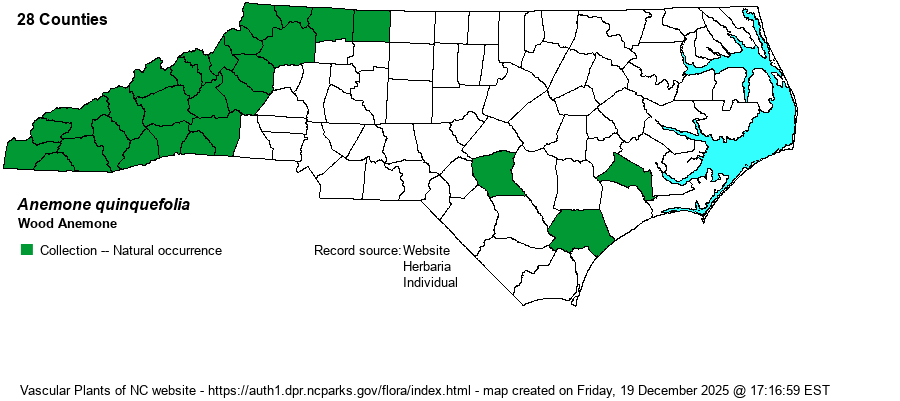| Section 6 » Order Ranunculales » Family Ranunculaceae |
Show/Hide Synonym
| taxonName | relationship | relatedTaxonName | relatedTaxonRefText | relComments |
|---|
|
|
|
|
| Anemone quinquefolia | = | Anemone quinquefolia var. quinquefolia | Flora of North America (1993b, 1997, 2000, 2002a, 2002b, 2003a, 2004b, 2005, 2006a, 2006b, 2006c, 2007a, 2009, 2010) | | | Anemone quinquefolia | = | Anemone quinquefolia var. quinquefolia | | | | Anemone quinquefolia | = | Anemone quinquefolia var. quinquefolia | | | | Anemone quinquefolia | = | Anemone quinquefolia var. quinquefolia | Flora of Virginia | | | Anemone quinquefolia | > | Anemone quinquefolia var. quinquefolia | Gleason and Cronquist (1991) | | | Anemone quinquefolia | > | Anemone quinquefolia var. quinquefolia | Fernald (1950) | | | Anemone quinquefolia | > | Anemone quinquefolia var. quinquefolia | | | | Anemone quinquefolia | > | Anemone quinquefolia var. quinquefolia | | | | Anemone quinquefolia | > | Anemone quinquefolia var. bifolia | Gleason and Cronquist (1991) | | | Anemone quinquefolia | > | Anemone quinquefolia var. bifolia | Gleason (1952) | | | Anemone quinquefolia | > | Anemone quinquefolia var. bifolia | | | | Anemone quinquefolia | > | Anemone quinquefolia var. bifolia | | | | Anemone quinquefolia | > | Anemone quinquefolia var. interior | Fernald (1950) | | | Anemone quinquefolia | > | Anemone quinquefolia var. interior | Gleason (1952) | | | Anemone quinquefolia | < | Anemone quinquefolia | Ziman et al. (2004)=Y. | | | Source: Weakley's Flora |
|
| Author | L. | |
| Distribution | Throughout the Mountains, and into a few of the higher Piedmont ranges, such as as the Sauratowns (Surry and Stokes counties). Also a few disjunct records in rich (mostly marl-derived) soils in the Coastal Plain (Cumberland, Jones, and Onslow counties). The SERNEC database contains records for this species from all across the state, but the editors feel that nearly all of these belong to A. lancifolia away from the Mountains. However, Weakley's (2018) map shows that the species is "common" across the Piedmont and "uncommon" in the Coastal Plain, quite at odds with the RAB (1968) map and the BONAP map. The Digital Atlas of the Virginia Flora also has this species as rather rare in the central and eastern Piedmont and most of the Coastal Plain. Thus, there is considerable confusion over its range east of the Mountains.
This is a Northern species, ranging across most of southern Canada and south to central GA and central AL. | |
| Abundance | Common and widespread in the Mountains. Range east of the Mountains, into the Piedmont and Coastal Plain, is uncertain (see Distribution). It could range from "common" to "very rare or absent", depending on the references. The NCNHP's State Rank of S4 is appropriate for the range map on this website, but it would be S5 if following Weakley (2018) and all of the SERNEC specimen records. | |
| Habitat | This is a species of rich hardwood forests, most often seen in Rich Cove Forests. It does occur into the higher elevations of the mountains, up to 5,000 feet or more, into Northern Hardwood Forests and in High Elevation Seep Forests, as well as Grassy Balds, among other natural communities. Downstate, it occurs mostly in Basic Mesic Forests. The Coastal Plain records are from soils over marl, such as Wet Marl Forest and Basic Mesic Forest communities. | |
| Phenology | Blooms from March to May. | |
| Identification | This is a slender, rather frail, herb that ranges only to about 6 inches tall. It has several basal leaves, and each is strongly cleft into 3-5 sections ("leaflets"); if 3, then the lateral sections are at least moderately cleft so as to appear almost split. On the upper part of the stem is another set of 2-3 very similar strongly-cleft leaves, though somewhat smaller in size. About 1-2 inches above these leaves is the solitary flower -- consisting of 5 bright white sepals that are elliptical and rounded at the tip, about 1 inch across when fully opened. This species is obviously confused with two other species; the low elevation A. lancifolia, which has the leaves cleft into 3 segments, but the lateral leaflets are seldom cleft/divided into even partial sections. Weakley (2018) points out additional, and probably stronger, characters: A. lancifolia has the terminal leaflet/segment lanceolate or ovate (broadest at or below the middle) and serrated on the margin to below the middle, and the sepals at least 15 mm (3/5-inch) long, producing a flower about 1.3 inches across. A. quinquefolia has leaflets broadest at or above the middle (elliptic, oblanceolate, or obovate), serrated only above the middle, and sepals less than 15 mm (3/5-inch) long. Quite a few plants seem to remain in vegetative condition all spring, not flowering; however, there should be at least a few flowers in the patch that will bloom. The species does not grow singly, but typically in patches that can be several square meters. When this species is in bloom, you might think it is easily seen; but it almost always grows in highly diverse sites with several dozen other spring-blooming wildflowers that are also competing for your attention! You could walk past a patch in bloom if there are taller or more strikingly flowered species nearby. | |
| Taxonomic Comments | None, but other species -- A. lancifolia and especially A. minima -- are at times included within it as varieties.
| |
| Other Common Name(s) | None | |
| State Rank | S4 | |
| Global Rank | G5 | |
| State Status | | |
| US Status | | |
| USACE-agcp | FACU link |
| USACE-emp | FACU link |

